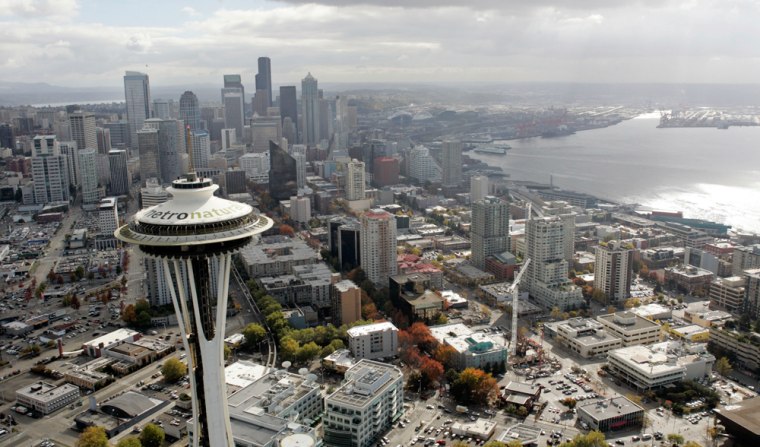Reversing a decade-long trend, many of America's largest cities are now growing more quickly than the rest of the nation, yet another sign of an economic crisis that is making it harder for people to move.
Census data released Wednesday highlight a city resurgence in coastal regions and areas of the Midwest and Northeast, due to a housing crunch, recession and higher gas prices that have slowed migration to far-flung suburbs and residential hotspots in the South and West.
The 2008 population figures show New York and Chicago made gains from higher births, while Philadelphia stanched population losses from earlier in the decade. Also showing rebounds were industrial centers in Minneapolis and St. Paul, Minn., Columbus, Ohio, and Lincoln, Neb., with economies focused on finance, health care, information technology or education. Detroit, with its ailing auto industry, declined.
Los Angeles, San Francisco, Seattle and Portland, Ore., all on the West Coast, registered growth, boosted partly by foreign-born immigrants who moved into and stayed in gateway cities. In contrast, former hotspot areas in Nevada and Arizona had significant slowdowns, as well as inland regions in California.
"Cities are showing a continued vitality as hubs of activity even as some suburban and exurban areas go through tough times," said William H. Frey, a demographer at the Brookings Institution. "It emphasizes the buoyancy of large established cities with diverse economies and populations."
Frey and other demographers said many of the population shifts could be longer-lasting. They noted that while the Sunbelt region is still growing, it is unlikely to return to the torrid growth rates of earlier in the decade before the housing bubble burst.
President Barack Obama has pledged to upgrade mass transit and push energy conservation, high-speed rail and other urban priorities. That could create shifts in residential patterns and city life, especially for younger couples and small families more likely to move.
"Suburban sprawl may not be dead, but it's certainly on hiatus," said Mark Mather, associate vice president of the nonprofit Population Reference Bureau. "Even if the economy recovered tomorrow, it might take a while for people to change their behavior. Attitudes just don't change overnight."
Transit helps growth
Robert E. Lang, co-director of the Metropolitan Institute at Virginia Tech, predicted that upscale, inner suburbs with developed transit systems will see bigger gains in the future. He noted that while far-flung exurbs have been steadily losing population, closer-in Virginia suburbs such as Arlington and Alexandria just outside Washington, D.C., jumped 3 percent and 2.9 percent in 2008, respectively, to rank among the 20 fastest-growing cities.
"In Arlington and Alexandria, we're seeing hints of a new growth model," Lang said, citing changing demographics in which there are fewer U.S. households with kids.
"These were places that were losing population. But they tore down the shopping malls, developed the transit system and put up apartment housing to accommodate singles and childless couples," he said. "They're a decade ahead of Lakewood, Colo., Tempe, Ariz., and other Sunbelt regions that now have transit."
Census estimates show:
- The 10 largest cities grew about 1 percent from the previous year, buoyed by sharp gains in Chicago and fewer losses in Philadelphia, compared to 0.9 percent for other cities. For much of the decade, the big cities had grown at roughly 0.5 percent — half the rate for elsewhere in the U.S.
- New York continued to be the nation's most populous city, with 8.4 million residents. Los Angeles ranked second at 3.8 million. Rounding out the top 10 were Chicago, Houston, Phoenix, Philadelphia, San Antonio, Dallas, San Diego and San Jose, Calif.
- For metropolitan areas greater than 1 million people, the growth rates of cities grew 1 percent, compared to 1.1 percent for suburbs. In 2001, city growth was half the rate for suburbs — 0.8 percent for cities compared to 1.6 percent for suburbs.
- New Orleans was the fastest-growing city in 2008, rising 8.2 percent from the previous year. Still, its population of 311,853 residents lagged its pre-Hurricane Katrina level of 484,674 in 2000. The city's population dipped in 2006 to 210,768.
- Four of the 10 fastest-growing large cities were in Texas: Round Rock, McKinney, Killeen and Fort Worth. North Carolina had two cities in the top 10, Cary and Raleigh; California also had two, Roseville and Irvine. Gilbert, Ariz., also was on the list.
The Census Bureau estimated annual population totals as of July 1, 2008, for cities, defined by boundaries of incorporated areas. The agency used local records of births and deaths, Internal Revenue Service records of people moving within the U.S. and census statistics on immigrants.
